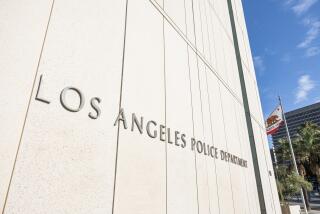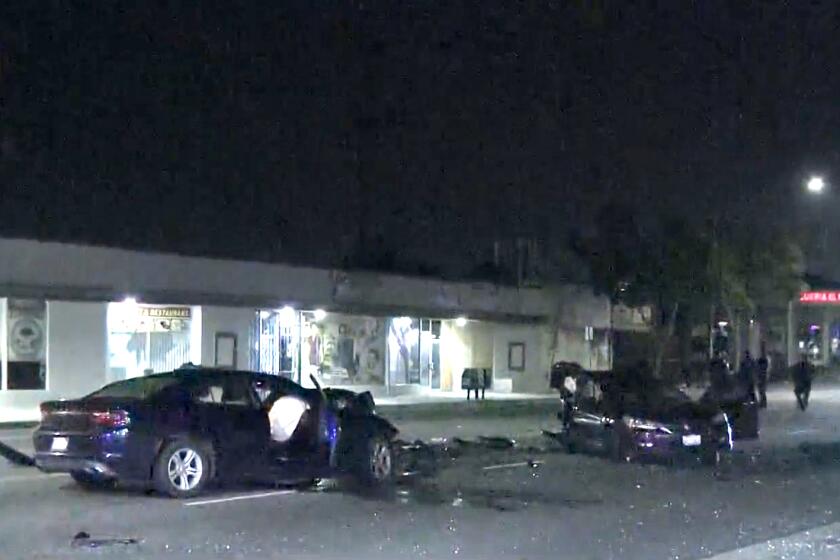Even Dinosaurs Can Learn New Tricks
- Share via
The cops who work in the west San Fernando Valley community policing office call it Jurassic Park.
It’s so named because most of the officers have been on the Los Angeles Police Department for a quarter of a century or more. In this youth-oriented world they are considered dinosaurs.
I had visited the place before, the first time after the 1992 riots, to try to understand community policing--a worthwhile but vague-sounding concept that has become one of the LAPD’s major anti-crime weapons.
Now the crime rate is down and a lot of police brass are giving community policing credit for it. So I thought I’d ask the dinosaurs whether they thought their efforts were worthwhile.
*
Last Thursday, as I passed through the doors of the community office, I was greeted by the boss, Sgt. Dan Mastro, who joined the department in 1976. Also there were Officers Ken Knox, Steve Kegley and Tim Kidd, all of whom had even more years with the LAPD. I noticed the room was decorated with pictures of the most famous dinosaur, John Wayne.
Knox, Kidd and Kegley are senior lead officers, important cops under the community policing scheme.
Community policing is a simple, common sense concept: Organize communities into small groups to help police officers do their work. Many Angelenos have come in contact with community policing at Neighborhood Watch meetings, where senior lead officers advise residents on the local crime situation and offer advice on burglar-proofing homes.
The senior leads do more. If a Neighborhood Watch group complains about bad lighting at a dangerous corner, the lead officer goes to the City Council office and asks the staff’s help in mobilizing City Hall bureaucrats to improve things. If there’s graffiti, the senior lead organizes neighbors in a cleanup campaign.
The neighbors also become spotters of potential crimes, turning in the license numbers of cars they think are suspicious or passersby that cause them concern.
Such a neighborhood group, recently complaining to police about noise from men living in a West Hills house, led to several arrests.
Without community policing, busy patrol officers usually put such nuisance calls at the bottom of the list. This one was turned over to the community policing operation and lead officer Knox looked into it. Other cops began watching the place and the neighbors’ complaints led to the arrest of nine men wanted for various offenses.
Community policing has taken hold strongly in areas such as the west Valley, where support for the LAPD has always been strong. When community police officers organize Neighborhood Watch groups there, they are usually preaching to true believers.
It’s much more difficult in areas where there is a long history of hostility to the LAPD.
“The effect of the network of gangs on neighborhoods in South-Central is stronger,” said Deputy Police Chief Mark Kroeker, who has been in charge of policing in both the Valley and South L.A. “The tendons of intimidation reach out deeper in those neighborhoods than it does in the west Valley.”
*
The west Valley community policing officers concede that a lot of cops in the department don’t support their efforts, regarding it as wasteful public relations effort to appease department critics. “Not everyone believes in it,” said Kegley. “But the officers who went out to that house and arrested those felons now understand what it is about.”
The west Valley cops think their efforts have reduced crime. “Almost certainly,” said Sgt. Mastro. But nobody knows for sure what caused the recent drop reported by the FBI. It could well have been the declining birthrate that began in the mid-60s, producing fewer young people.
What is certain is that such policing methods will remain part of the LAPD’s arsenal, along with guns, patrol cars, SWAT teams, detectives and helicopters.
It makes the cops’ job much more complicated than when the old TV show “Dragnet” gave the LAPD its famous grim face. But today’s world, and L.A., is much more complicated than it was then.
More to Read
Sign up for Essential California
The most important California stories and recommendations in your inbox every morning.
You may occasionally receive promotional content from the Los Angeles Times.










